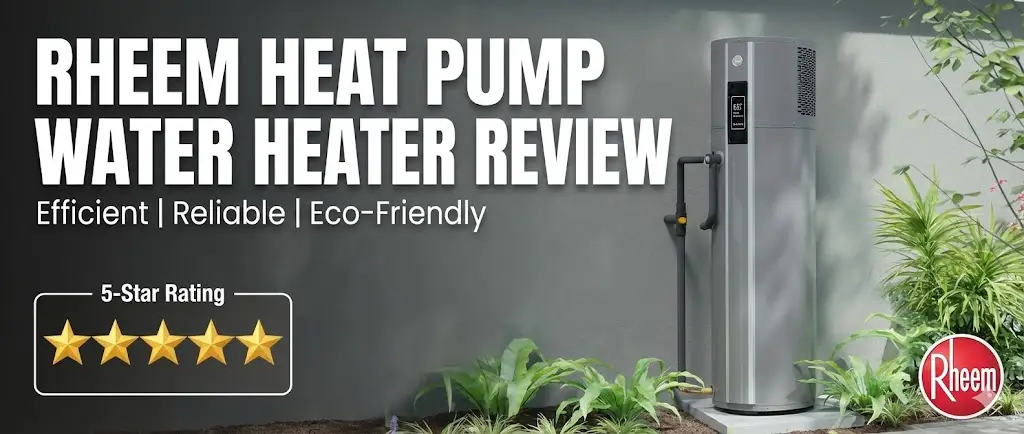
Power bills linked to heating water have long been a silent killer of household budgets, consistently ranking as the second-largest […]
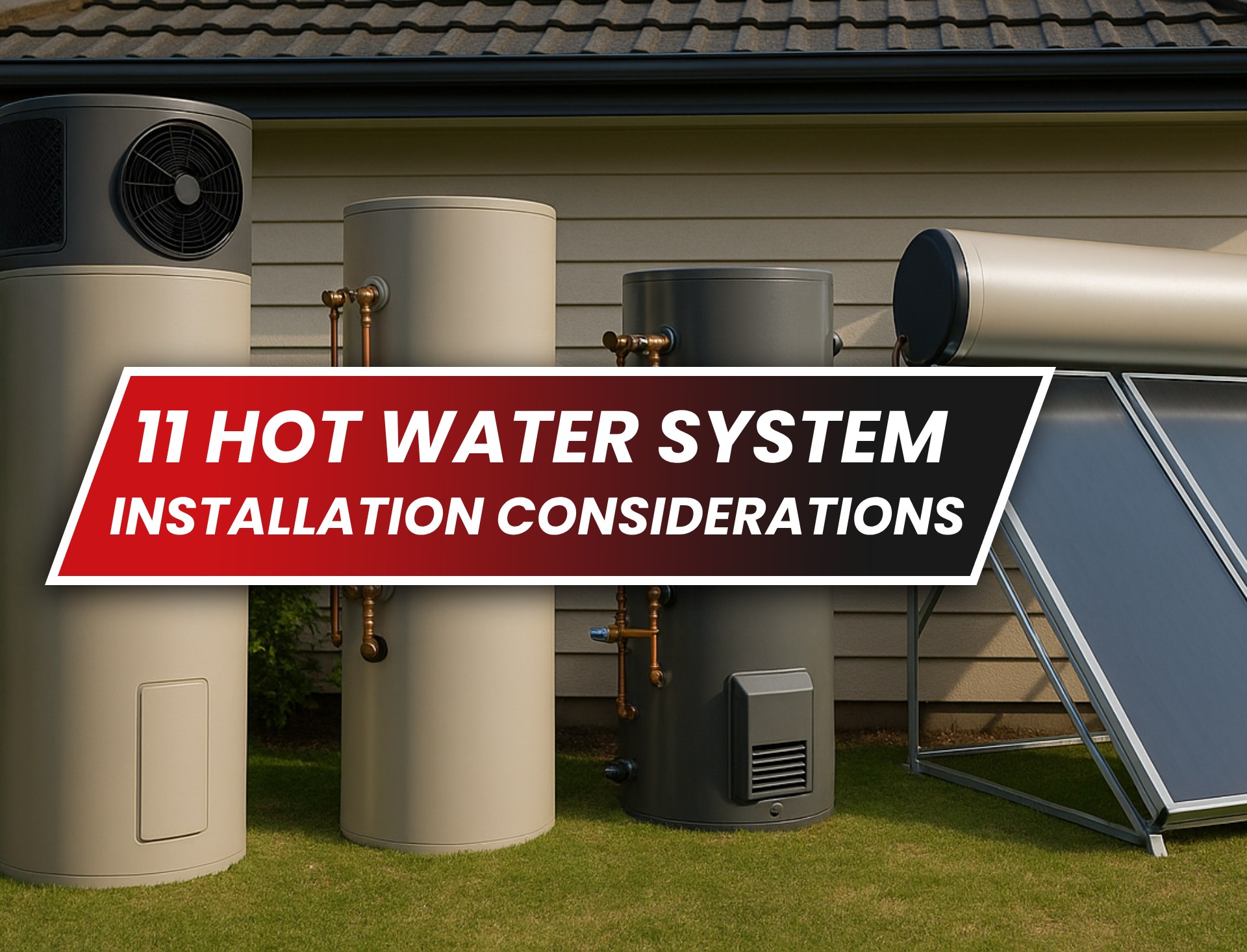
You don’t think about a hot water installation until you’re halfway through your shower when the hot water suddenly turns ice cold.
You jump back, soap stinging your eyes, and the only thing you can do is yell angrily, “Who used up all the hot water?!”
It’s a familiar frustration in busy households.
One person takes a long shower, someone else starts the washing machine, and before you know it, poof! – The hot water is gone.
It’s beyond frustrating, but do you ever wonder why this happens?
Most of the time, the issue isn’t that something’s broken. The problem is that your hot water tank isn’t big enough to keep up with your family’s hot water needs.
If the system can’t handle the demand, you’re bound to get hit with that cold water shock repeatedly.
You must rethink your water heating system to eliminate these hot water issues.
But before you do, make the following hot water installation considerations:
When selecting a hot water system, you should first consider your household’s hot water demand.
Each house is unique, and two homes cannot possibly use an identical quantity of hot water, even if there are a similar number of occupants.
Estimating how hot water is used within your household will allow you to purchase a water heater that can meet the demand without running into trouble or rising hot water bills.
So, how do you estimate hot water use for your family?
Ask yourself the following questions:
As a general principle, estimate hot water demand assuming that every Australian adult requires 50+ L daily.
So, know exactly how many hot water users are within your household and do the math.
Add it all together, including appliances, and you will have a workable figure for your hot water installation.
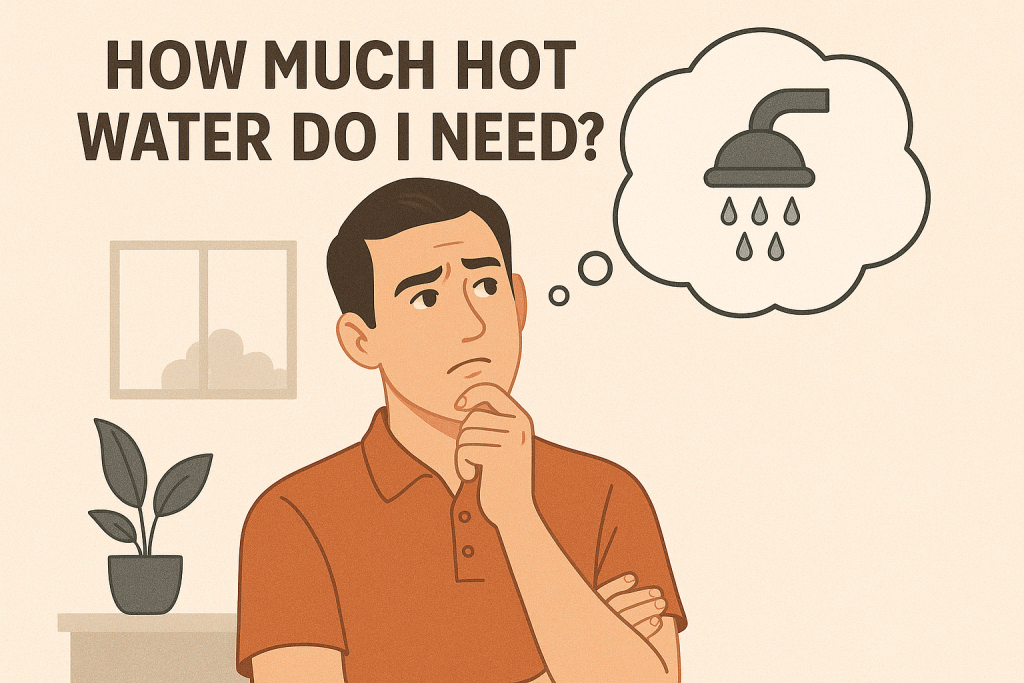
Let’s be honest. Most homeowners are reluctant to embrace new changes.
We usually assume that what we know or have is the best, so many make the mistake of upgrading to the same hot water system they had or to the ones they’re familiar with, without considering if there’s a more efficient or cost-effective option.
If you have this kind of thinking, we beg you to change.
Things have evolved, and more innovative, energy-efficient hot water installation options are now available.
Here’s a breakdown of the most popular systems, how they work, and the best environments for using them:
Understanding these hot water installation systems in detail will help you make an informed decision that will suit your needs based on your location, energy costs, and long-term savings.

Energy efficiency indicates how well a water heater utilises energy to heat water to a comfortable temperature.
It’s a consideration because an efficient water heater uses less energy, has lower costs, and has an extended lifespan.
When searching for energy-efficient water heaters, check the Energy Star rating sticker.
The higher the number of stars, the more efficient the heater will be.
You will, however, realise that such models with more Energy Stars have a higher price tag.
This should not scare you at all.
Why?
Because the unit’s energy savings will soon recoup these initial hot water installation costs and leave you enjoying affordable hot water rates.
Still, on efficiency, look at how the system heats water.
Continuous flow units only work when hot water is used, so they do not waste energy on standby heating.
Conversely, storage heaters heat water throughout the day, so they will use electricity even if you do not use hot water.
This repeated reheating will cause increased electricity or gas costs over the years.
Finally, consider additional smart energy-saving options such as timers, thermostatic controls, and off-peak operation.
They let the system run only when necessary or at off-peak hours, saving energy costs.
You’ll easily get enticed by a low-cost online price for a hot water system, but that figure does not often reflect the entire story.
The actual price is not only for the unit; it includes other costs on plumbing, fixtures, removal of the previous unit, and any retrofit work required to install the new unit.
In Australia, a standard hot water installation costs between $500 and $5,000.
It can even occasionally be more, based on circumstances.
Replacing a like-for-like unit (such as swapping a gas unit for another one) is typically inexpensive and straightforward.
However, upgrading from traditional gas/electric to renewable solar/heat pump or relocating the unit outside from an indoor location will be more expensive because of additional parts and labour.
For convenience, request a complete quote before you commit.
A trustworthy installer will take you through every expense upfront, helping you avoid surprises and budget wisely.
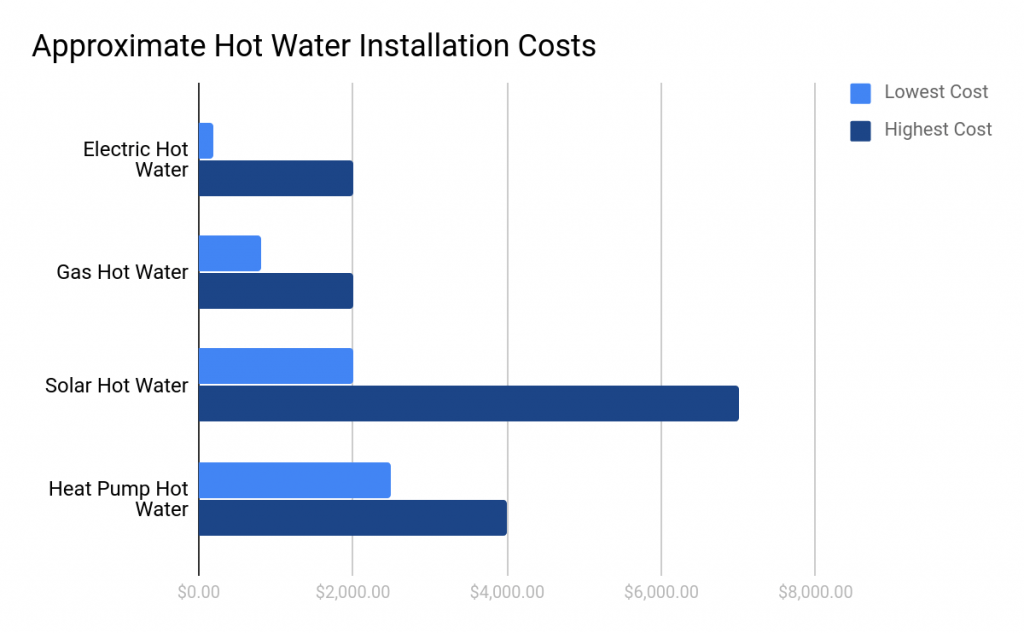
Not all hot water systems accommodate the same water pressure, affecting your shower experience.
If you have low water pressure settings at home, adding a high-pressure system will likely damage pipes and fittings since the system will push water more than the plumbing can handle.
Conversely, putting a low-pressure system into a high-pressure zone would create poor flow since the system can’t keep pace with the house’s water pressure.
Water pressure is a particularly relevant consideration in Australian houses constructed during the 90s.
These houses tend to have plumbing fixtures designed for low-pressure applications, so using high-pressure fixtures could result in issues.
The good news is that you can always check your water pressure using a pressure gauge or call in a professional to determine and match it with the best water heater.
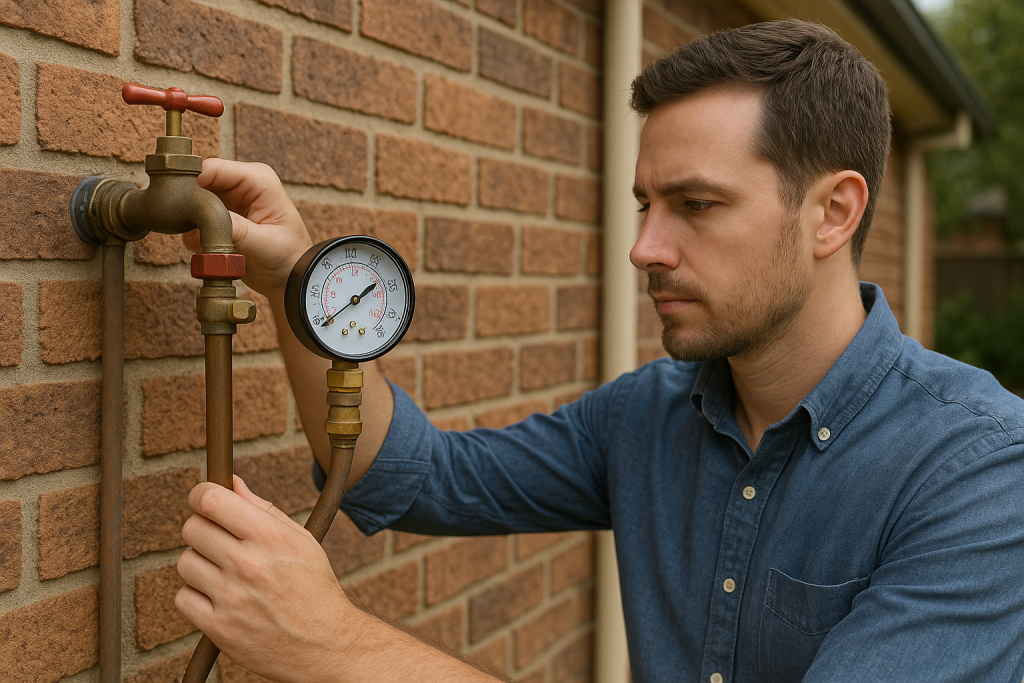
You may be eyeing a hot water installation, but where will it go?
Space is more significant than most individuals consider, particularly in city houses where every inch counts.
Some systems are big and bulky, requiring large installation spaces, while others are more compact and can be concealed easily.
Still, some require indoor installations, while others must be installed outdoors for proper functioning.
To determine the correct choice, think about what space you are working with and what space will be needed for hot water.
The following is a brief checklist:
Solar water heaters: You will require ample rooftop space for installation. The area must be free from any source of shading to maximise sunlight.
Consider all these space requirements and seek professional help if unsure.
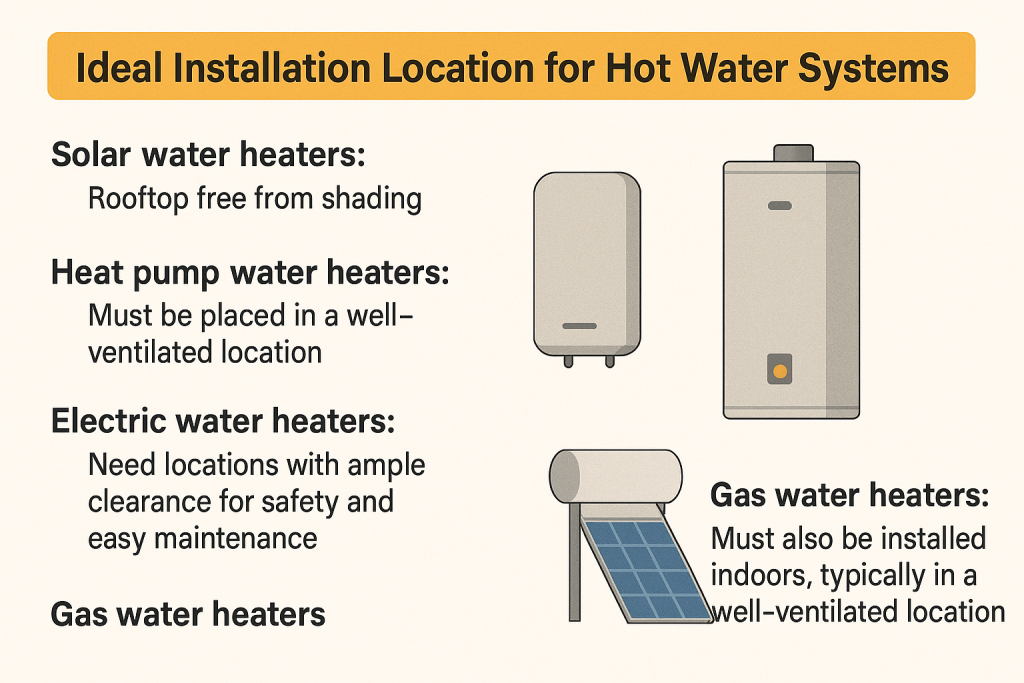
Australia’s climate is incredibly diverse such that, what suits a home in chilly Hobart might be a poor fit for someone in sunny Cairns.
Therefore, you must consider your climate and match it with the most adaptable hot water system.
Here is a quick break to help you make your choice:
Further, ask yourself the following:
The thing is to tailor your choice to the local weather. This will mean better efficiency, fewer breakdowns, and a longer system lifespan.
Don’t look at the warranty document as just another piece of paper; it has crucial information that can tell you how much faith the manufacturer has in their product.
A solid hot water installation should have at least a 5-year warranty, but some extend to 10 or even 12 years.
Check what’s covered. Is it just the tank? Or does it include parts and labour?
Some brands split warranties: 10 years on the cylinder and 1 year on parts and labour. That kind of split can cost you if repairs are needed.
Make sure all the parts have reasonable coverage.
Also, look into the average lifespan.
Storage tanks typically last 8–12 years, while continuous flow and heat pump systems can push beyond 15 if maintained well. Solar systems vary depending on quality and conditions.
The key to prolonging lifespan and benefiting from the warranty is proper maintenance.
Even the best system won’t last if neglected, and the manufacturer won’t honour warranty claims.
Hot water systems are among the largest polluters in Australia, producing roughly 20% of residential emissions.
As an environmentally concerned homeowner, selecting a low-emitting hot water system would go a long way towards saving our planet.
It’s not only about the environment.
Australia has vowed to reach a net-zero emission by 2050, so stricter measures could be implemented.
For example, the government will likely limit or phase out high-emitting systems, particularly for new constructions or renovations.
Thus, considering a low-emitting hot water installation instead of a high-emitting system today future-proofs your investment.
Having low-emission systems is also an advantage because it increases the value of your property.
More people are seeking energy-efficient features, so you can attract them with sustainable systems.
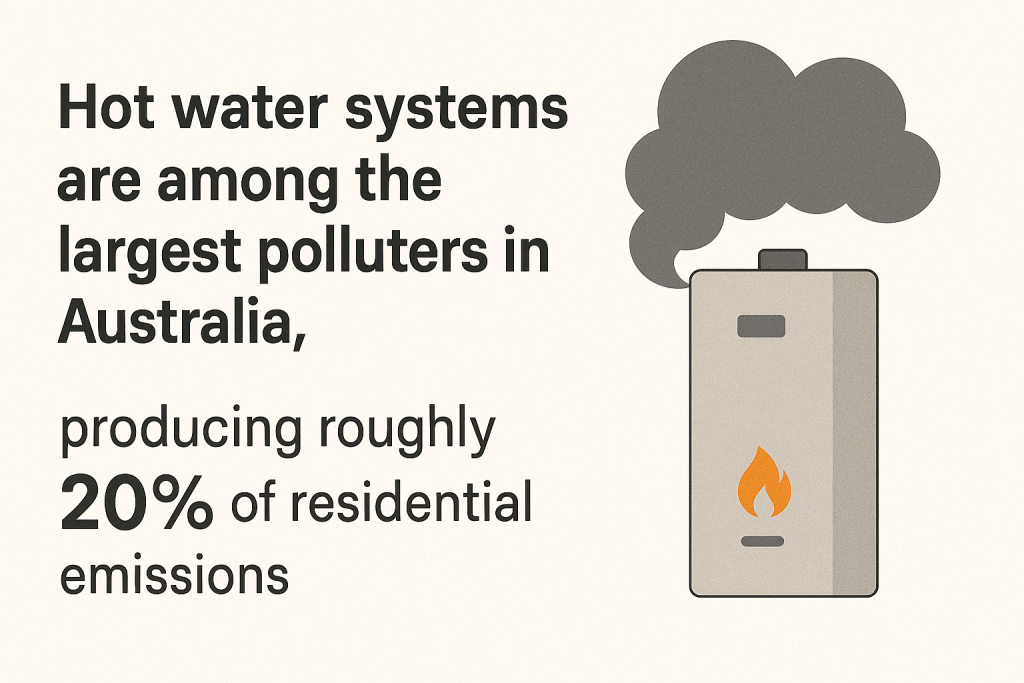
Your hot water installation might work fine for you today, but what if you plan to grow your family or take on housemates?
It happens more often than you think: people install the perfect-sized system only to outgrow it within two years.
The best way to future-proof is to think in 5 to 10-year terms.
If you’re expecting children, elderly parents moving in, or even switching to working from home, all of that adds to daily hot water demand.
Also, consider lifestyle changes.
Will you install a second bathroom? A bigger bathtub? A new laundry setup?
Considering all these, it is better to slightly oversize your system now than be forced into another upgrade soon.
You may be inclined to let your DIY friend fit out your brand-new hot water unit, but you could find yourself in trouble in Australia.
Only licensed electricians and plumbers are legally allowed to manage hot water installations.
Per the country’s law, an installer must possess an up-to-date license from a state or territory licensing body, such as Fair Trading NSW or the Victorian Building Authority.
Such installers do more than mount the system.
They check your home’s water pressure, energy source, space, and adherence to Australian Standards and local plumbing regulations, which you often overlook with do-it-yourself installations.
Moreover, having a licensed installer also helps secure your warranty since manufacturers require professional installation and may void warranty claims due to improper installation by unqualified professionals.
Lastly, a qualified professional will teach you how to use your hot water system effectively, discuss what you need to do for maintenance, and inform you when it is time for a service.
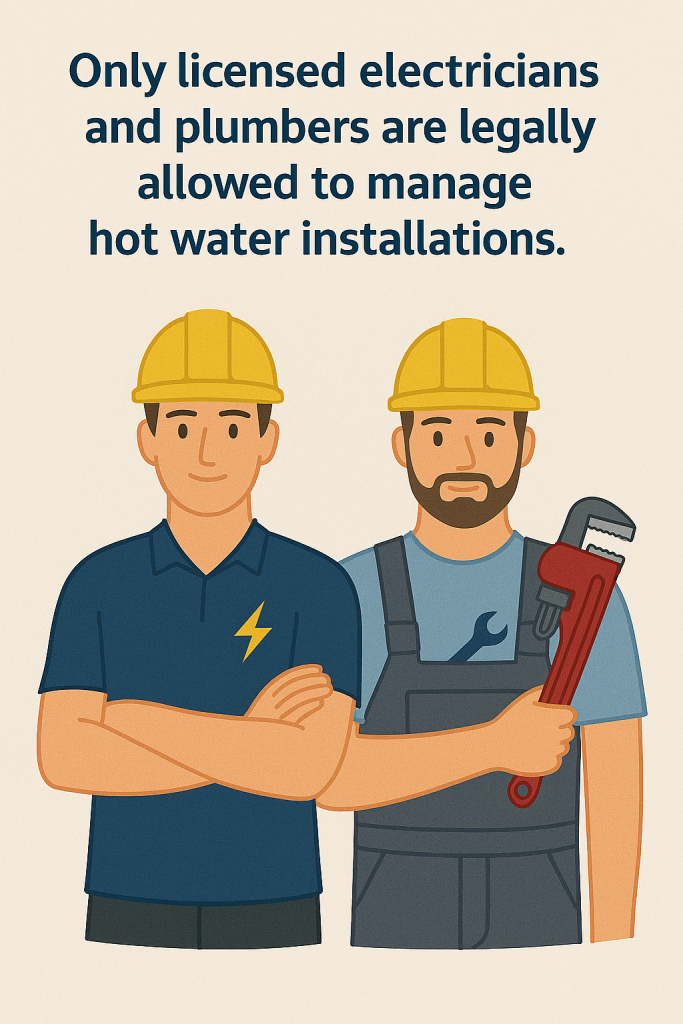
In Australia, a typical shower consumes about 9–18 litres per minute.
Based on the shower head, a 10-minute shower would use between 90 and 180 litres.
The exact amount depends on whether you’re using a water-efficient showerhead or a standard one
Every adult in Australia uses about 50 litres of hot water per day, which means a 2-person family requires about 100+ litres of hot water per day.
The actual requirement depends on each person’s hot water usage.
The main hot water users within a house are:
Showers (up to 50% of hot water consumption)
Washing machines
Kitchen faucets (although fewer than above)
Low-flow showerheads or flow restrictors can assist. Flow restrictors lower your water consumption yet provide normal shower pressure.
They control how much water flows through the showerhead, allowing you to conserve water and energy without compromising comfort.
For a 2-person household, a 125–160 litre electric storage tank, or continuous flow (instant) with an output rating of 16–20 litres per minute, is usually adequate.
Bigger families require bigger systems. Always consider how many showers, appliances, or taps will run at any given time.
Begin by inspecting the electric power source (if electrical) or gas source (if gas-fired).
Check whether the pilot light or circuit breaker has been turned off.
If you use a timer, check that it is properly programmed.
That varies with your system:
Electric storage: 30 minutes to more than an hour.
Gas storage: 30-60 minutes.
Instant (on-demand flow): Virtually no waiting; hot water is produced when needed.